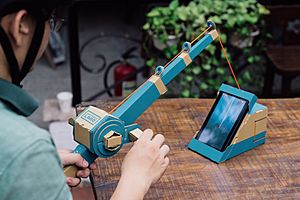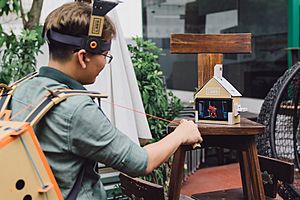Nintendo Labo facts for kids
| Variety Kit, Robot Kit, Vehicle Kit, and VR Kit | |
|---|---|

Nintendo Labo logo
|
|
| Publisher(s) | Nintendo |
| Publication date |
|
| System(s) | Nintendo Switch |
| Material(s) required | Cardboard construction set, craft materials |
| Media type | Nintendo Switch game card |
| Slogan | Make, Play, Discover |
Nintendo Labo is a super fun and creative idea from Nintendo, released in April 2018. It's a unique mix of video games and real-life building.
Nintendo Labo comes with special kits that include cardboard pieces and other materials. You use these to build cool creations called "Toy-Cons." These Toy-Cons then work with your Nintendo Switch console and Joy-Con controllers. It's like bringing your game to life! Nintendo made Labo to help you learn about engineering, physics, and even basic computer programming in a hands-on way.
Contents
Building and Playing with Toy-Cons
Nintendo Labo is sold as different kits. Each kit has pre-cut cardboard sheets and other items. You use these to build one or more "Toy-Cons." Each kit also includes a Nintendo Switch game card. This card has easy-to-follow instructions for building your Toy-Cons. It also has the game software that your Toy-Cons will interact with.
Once you build a Toy-Con, you put your Nintendo Switch screen or Joy-Con controllers inside it. How each Toy-Con works is different. For example, the piano Toy-Con uses the Right Joy-Con's infrared sensor to know which keys you press. Robotic Toy-Cons move using the Joy-Con's HD Rumble feature. You can even decorate your cardboard creations with pens, tape, and other craft supplies! The game software also teaches you how the Toy-Cons work, like how infrared sensing helps the piano.
Toy-Con Garage: Create Your Own Fun
The Nintendo Labo software has a cool feature called "Toy-Con Garage." This lets you create and program your own Toy-Cons! You can use pieces from your Labo kits or even your own materials.
Toy-Con Garage works by connecting simple commands. You link "input" actions to "output" results. When an input happens, it triggers the connected output. For example, an input could be pressing a button or moving a controller. An output could be making the Joy-Con vibrate or lighting up the Switch screen. You can even add "middle nodes" to change how inputs work. This means you can make really complex and unique creations!
Awesome Labo Kits to Explore
Two main Labo Kits, the Variety Kit and Robot Kit, were first released in April 2018. You can also buy extra accessories like stencils and stickers. If you need to replace a cardboard part, you can buy new ones or even download free templates to cut them yourself.
Variety Kit: Five Ways to Play
The Variety Kit lets you build five different Toy-Cons:
- Two remote-controlled cars: The Joy-Cons' vibrations make the car move and steer. You control it like a normal RC car using your Switch. The car can even follow targets using the Right Joy-Con's IR camera!
- A fishing rod: Joy-Cons fit into the reel and handle. You use motion to play a fishing game on your Switch.
- A toy piano: This piano has a full octave of keys. Your Switch sits on top like a music stand.
- A motorbike: Joy-Cons go into the handlebars. You use them to steer in racing games. This Toy-Con even works with Mario Kart 8 Deluxe!
- A house: You can insert different parts into this house. These parts interact with games on your Switch screen.
The game cartridge in this kit teaches you how to build each Toy-Con. It also has games for each one. Some Toy-Cons have multiple games. For instance, with the motorbike, you can race or even create new tracks using the IR sensor!
Robot Kit: Become a Giant Robot!
The Robot Kit lets you build a cool mecha suit! It includes a visor for your head that holds the left Joy-Con for motion sensing. A backpack holds the right Joy-Con to read your hand and foot movements. This lets you control a giant robot in a virtual world on your screen!
The software has different game modes:
- Robot mode: Control a giant robot as it attacks a city. You can even make it fly or turn into a tank!
- VS mode: Fight against another player's giant robot. (Both players need a Robot Toy-Con for this.)
- Challenge mode: Complete missions to unlock special robot abilities.
- Robo-Studio mode: Put your Switch into the Toy-Con and play sound effects based on your movements.
- Hangar: Customize how your virtual robot looks.
Vehicle Kit: Drive, Fly, and Dive!
Nintendo released the Vehicle Kit in September 2018. This kit lets you build three different steering consoles: one for a car, one for a plane, and one for a submarine. Each has a slot for a special "key" Toy-Con.
The game lets you control cars, planes, and submarines. You can switch between them by moving your Toy-Con key to a different console. You can even play with a friend! The kit also has parts for a pedal Toy-Con to power your vehicles.
VR Kit: Step into Virtual Worlds!
The VR Kit came out in April 2019. It centers around cardboard goggles that let you see stereoscopic 3D images using your Switch. It's similar to Google Cardboard.
The main kit comes with five items that attach to the VR Goggles: a blaster, a camera, a bird, an elephant, and a pinwheel. A wind pedal is also included with the full kit. You can also get a smaller starter kit with just the Goggles and blaster, and buy the other attachments later.
Labo Fun with Other Games
After Nintendo Labo came out, many other popular Switch games got free updates to work with certain Toy-Cons!
- In June 2018, Mario Kart 8 Deluxe was updated. You can now use the motorbike Toy-Con from the Variety Kit to control your racer! The car steering wheel from the Vehicle Kit also works with Mario Kart 8 Deluxe.
- The piano-based rhythm game Deemo added support for the piano Toy-Con in October 2018.
- Fishing Star: World Tour supports the Toy-Con Fishing Rod.
- In April 2019, The Legend of Zelda: Breath of the Wild and Super Mario Odyssey got updates for VR game modes using the VR Kit.
- Super Smash Bros. Ultimate also got a limited VR mode.
- Captain Toad: Treasure Tracker received a VR mode update in July 2019.
- Other games like Puchikon 4 SmileBASIC, Spice and Wolf VR, and Neonwall also added support for various Labo Toy-Cons.
Sales and Awards
Nintendo Labo has been quite popular! In Japan, the Variety Kit sold over 90,000 copies in its first week. By March 2019, the Variety Kit had sold 330,000 units in Japan and over 1 million worldwide. By the end of 2018, all Labo kits combined had sold 1.39 million units globally.
Nintendo Labo has also won many awards for its innovation and family-friendly fun:
| Year | Awards | Category | Result |
|---|---|---|---|
| 2018 | Golden Joystick Awards 2018 | Nintendo Game of the Year | Nominated |
| The Game Awards 2018 | Best Family Game | Nominated | |
| 2019 | New York Game Awards 2019 | Central Park Children's Zoo Award for Best Kids Game | Won |
| NAVGTR Awards | Game, Special Class | Won | |
| Game Developers Choice Awards | Innovation Award | Won | |
| 15th British Academy Games Awards | Family | Won | |
| Game Beyond Entertainment | Nominated | ||
| Game Innovation | Won | ||
| Italian Video Game Awards | Best Family Game | Won | |
| Innovation Award | Nominated | ||
| Games for Change Awards | Most Innovative | Nominated | |
| Game of the Year | Won | ||
| CEDEC Awards | Game Design | Won | |
| Japan Game Awards | Special Award | Won | |
| Golden Joystick Awards 2019 | Best VR/AR Game ("VR Kit") | Nominated | |
| 2020 | New York Game Awards 2020 | Coney Island Dreamland Award for Best AR/VR Game ("VR Kit") | Nominated |
Images for kids
See also
 In Spanish: Nintendo Labo para niños
In Spanish: Nintendo Labo para niños





